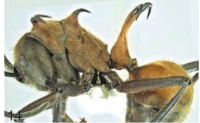Polyrhachis maliau
| Polyrhachis maliau | |
|---|---|

| |
| Scientific classification | |
| Kingdom: | Animalia |
| Phylum: | Arthropoda |
| Class: | Insecta |
| Order: | Hymenoptera |
| Family: | Formicidae |
| Subfamily: | Formicinae |
| Tribe: | Camponotini |
| Genus: | Polyrhachis |
| Subgenus: | Polyrhachis |
| Species group: | bihamata |
| Species: | P. maliau |
| Binomial name | |
| Polyrhachis maliau Kohout, 2014 | |
The type specimens of Polyrhachis maliau were collected from a single trail of workers foraging over low vegetation along a creek. At the type locality it was found sympatric with Polyrhachis bihamata.
Identification
A member of the bihamata group of the subgenus Polyrhachis. Kohout (2014) - Polyrhachis maliau is characterised by moderately divergent petiolar spines, similar to those in Polyrhachis mindanaensis, Polyrhachis montana and Polyrhachis ypsilon. It is most similar to P. mindanaensis but differs a number of characters including its distinctly smaller size (HL 2.21 – 2.37 in maliau versus 2.62 – 2.77 in mindanaensis), more slender body, pyramidal rather than lanceolate mesonotal spines and the presence of numerous hairs lining the antennal scapes, that are virtually absent in P. mindanaensis. In addition, the body in P. maliau is generally more polished, in contrast to rather dull and opaque P. mindanaensis.
Keys including this Species
Distribution
Latitudinal Distribution Pattern
Latitudinal Range: 4.733333333° to 4.733333333°.
| North Temperate |
North Subtropical |
Tropical | South Subtropical |
South Temperate |
- Source: AntMaps
Distribution based on Regional Taxon Lists
Indo-Australian Region: Borneo, Indonesia, Malaysia (type locality).
Distribution based on AntMaps
Distribution based on AntWeb specimens
Check data from AntWeb
Countries Occupied
| Number of countries occupied by this species based on AntWiki Regional Taxon Lists. In general, fewer countries occupied indicates a narrower range, while more countries indicates a more widespread species. |

|
Estimated Abundance
| Relative abundance based on number of AntMaps records per species (this species within the purple bar). Fewer records (to the left) indicates a less abundant/encountered species while more records (to the right) indicates more abundant/encountered species. |

|
Biology
Castes
Sexuals and immature stages unknown.
Nomenclature
The following information is derived from Barry Bolton's Online Catalogue of the Ants of the World.
- maliau. Polyrhachis (Polyrhachis) maliau Kohout, 2014: 16, figs 10, 13–14 (w.) WEST MALAYSIA.
Unless otherwise noted the text for the remainder of this section is reported from the publication that includes the original description.
Description
Description
Worker
Description by Kohout (2014).
Dimensions (holotype cited first): TL c. 9.42, 9.17 – 9.93; HL 2.28, 2.21 – 2.37; HW 1.96, 1.91 – 2.02; CI 86, 82-88; SL 2.87, 2.77 – 2.92; SI 146, 141 – 150; PW 1.01, 0.87 – 1.06; PeH 2.29, 2.25 – 2.47; PeI 100, 98 – 109; MTL 3.93, 3.76 – 3.98 (1+16 measured).
Mandibles with 5 teeth. Anterior clypeal margin arcuate, entire. Clypeus with posteriorly raised, median carina; clypeus convex in profile with basal margin strongly impressed medially, laterally basal margin indicated by thin, sculpture-breaking line. Frontal triangle distinct. Frontal carinae sinuate with distinctly raised margins; frontal furrow well impressed. Sides of head in front of eyes converging into mandibular bases in weakly convex line; behind eyes, sides rounding into relatively narrow occipital margin. Eyes moderately convex, in full face view not, or only marginally reaching lateral cephalic outline. Median ocellus obscure, lateral ocelli lacking. Mesosomal dorsum immarginate; pronotum armed with long, hook-shaped spines. Mesonotal dorsum bearing a pair of pyramidal, somewhat dorsomedially flattened spines that are strongly curved posteriorly and weakly bent ventrally from midlength. Metanotal groove indistinct dorsally, weakly impressed laterally. Propodeal dorsum immarginate with posterior corners produced into short, medially unconnected, transverse ridges; weakly concave declivity distinctly shorter than propodeal dorsum. Petiole columnar, bearing a pair of hook-shaped spines, distinctly divergent from bases. Anterior face of first gastral segment flat at base, widely rounding onto dorsum.
Mandibles finely, longitudinally striate. Head, mesosoma and petiole very finely reticulatepunctate, semi-polished; tips of spines smooth and highly polished. Gaster finely shagreened, moderately polished.
Mandibular masticatory borders with numerous curved golden hairs and closely appressed short hairs towards bases. Anterior clypeal margin medially with several long, golden setae and few shorter setae fringing margin laterally. Mostly medium length, semierect to erect, golden hairs over most body surfaces; hairs distinctly shorter and less abundant along inferior surfaces of antennal scapes and completely absent from antennal funiculi, tips of spines, propodeal declivity, posterior face of petiole and dorsal surfaces of femora. Appressed to suberect, golden pubescence rather abundant over entire body and appendages, without obscuring underlying sculpturation.
Head, including mandibles and antennae, tips of spines and legs, except coxae and bases of femora, black. Mesosoma and petiole light reddish-brown. First gastral segment light reddish-brown with subsequent segments and venter of gaster black; margins of segments diffusely and narrowly lined reddish-brown. Coxae, trochanters and bases of femora dark to very dark reddish-brown.
Type Material
HOLOTYPE: BORNEO, SABAH, Maliau Basin, Ginseng Camp, 04º44’N, 116º55’E, c. 700 m, 27.ii.-11.iii.2005, rf., strays on ground & low vegetation, R.J. Kohout & Effazilla Waty, acc. 2005.64 (worker). PARATYPES: data as for holotype (83 workers) Type distribution: Holotype and 3 paratypes in ITBC; most paratypes in QMBA; 2 paratypes each in ANIC, BMNH, CASC, MCZC and NMNH. Polyrhachis maliau was listed as a new species “P. (Polyrhachis) sp. 01” by Kohout & Maryati Mohamed (2008).
References
- Kohout, R.J. 2014. A review of the subgenus Polyrhachis (Polyrhachis) Fr. Smith (Hymenoptera: Formicidae: Formicinae) with keys and description of a new species. Asian Myrmecology 6, 1–31.
- Zettel, H. 2019. Two new species from Malaysia and further taxonomic notes on Polyrhachis s.str. (Hymenoptera: Formicidae). Zeitschrift der Arbeitsgemeinschaft Österreichischer Entomologen 71: 57-73.
References based on Global Ant Biodiversity Informatics
- Kohout R. J. 2014. A review of the subgenus Polyrhachis (Polyrhachis) Fr. Smith (Hymenoptera: Formicidae: Formicinae) with keys and description of a new species. Asian Myrmecology 6: 1-31.

